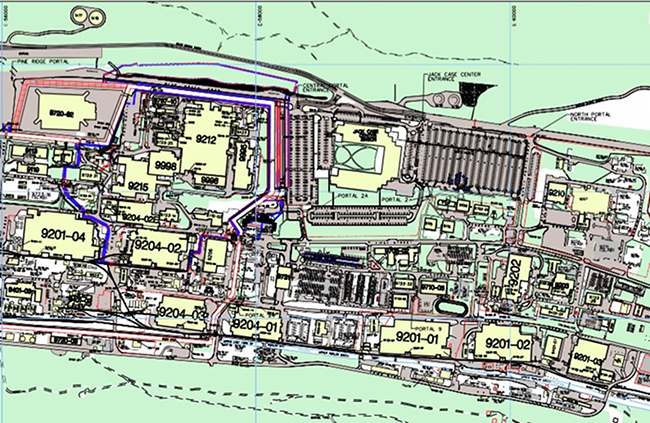
The sign at the main entrance to the Y-12 National Security Complex is pictured above on Sunday, Aug. 6, 2017. (File photo by John Huotari/Oak Ridge Today)
The National Nuclear Security Administration wants a new Lithium Production Facility at the Y-12 National Security Complex to be fully operational before 2030, officials said.
Federal officials have already approved the need for the new Lithium Production Facility, and they said it could be built on the east side of the 811-acre plant, possibly where the Biology Complex is now.
It could replace the “aging and obsolete” 9204-2 building, which is on the west side of Y-12.
A cost estimate is not yet available.
Steven Wyatt, public affairs manager for the National Nuclear Security Administration Production Office, said the Lithium Production Capability Project is in an early design phase. That design phase is associated with what is known as “Critical Decision—1, Approve Alternative Selection and Cost Range.”
“It is premature, at this time, to have a cost estimate as options for meeting specific program requirements are being evaluated,” Wyatt said in an emailed response to questions on May 30.
“The goal is to have the facility fully operational before 2030,” Wyatt said in response to a question about the construction timeline.
The current lithium production facility, Building 9204-2, was built as part of the Manhattan Project. It has been used for other purposes since World War II, after Y-12’s uranium enrichment mission ended, Wyatt said. Building 9204-2 is roughly the same size as the other eight buildings at Y-12 that contained calutrons for uranium enrichment.
“It has about 350,000 square feet of operational space used for special material production missions but is oversized for today’s mission, has a degrading infrastructure, and is expensive to maintain,” Wyatt said.
Lithium is used in the nation’s nuclear weapons stockpile, but federal officials can’t elaborate on how it is used and whether it is used at Y-12 or shipped elsewhere.
“We are not at liberty to discuss specifics about how this material is used for national security purposes,” Wyatt said.
He said the NNSA also can’t discuss the specific amount of materials that are processed in the lithium production facility.
Congress enacted $5 million for the project in the current fiscal year, fiscal year 2018, Wyatt said. The NNSA requested $19 million for fiscal year 2019, which starts October 1, but federal officials won’t know what funding is actually available until Congress passes the fiscal year 2019 budget.
Building the Lithium Production Facility where the Biology Complex is located now would not change security requirements on the east end of the plant, Wyatt said. Building 9204-2, the current facility, is located within the Y-12 Protected Area on the west side of the plant.
“The new facility will not be located in a ‘Protected Area,’ but it will be in the ‘Property Protection Area’ of the plant and will have security appropriate for this facility,” Wyatt said.
Like the current facility, the new facility will produce non-nuclear materials.
Current plans call for demolishing the Biology Complex, possibly within the next three to four years.
Until Building 9204-2 is replaced with a new facility, Y-12 and the NNSA will continue to make necessary improvements to Building 9204-2, Wyatt said.
Maintenance issues with Building 9204-02, which is being downgraded to a non-nuclear facility, have included concrete repairs, upgrades and replacements of humidity control systems, upgrades to electrical systems and fire safety systems, and improvements to process equipment.
Y-12 was built to enrich uranium for the world’s first atomic weapons as part of the top-secret Manhattan Project during World War II. Today, Y-12’s missions include work on nuclear weapons, retrieving and storing nuclear materials, and helping to provide fuel for the nation’s naval reactors.
More information will be added as it becomes available.

Federal officials have already approved the need for a new Lithium Production Facility at the Y-12 National Security Complex, and in May 2018, they said it could be built on the east side of the 811-acre plant, possibly where the Biology Complex, the brick building at center, is now. The east side of Y-12 is pictured above from Scarboro Road on Sunday, May 20, 2018. (Photo by John Huotari/Oak Ridge Today)

The new Lithium Production Facility at the Y-12 National Security Complex could be built where the Biology Complex is now in the area on the east side of the plant and pictured above at upper right (you may be able to see one building numbered 9210 to the east of a parking lot at center-right and the Jack Case Center at top-center), and it would replace Building 9204-02 on the west side of the plant, close to the left of the image above. (Map courtesy CNS Y-12)
Do you appreciate this story or our work in general? If so, please consider a monthly subscription to Oak Ridge Today. See our Subscribe page here. Thank you for reading Oak Ridge Today.
Copyright 2018 Oak Ridge Today. All rights reserved. This material may not be published, broadcast, rewritten, or redistributed.
Leave a Reply